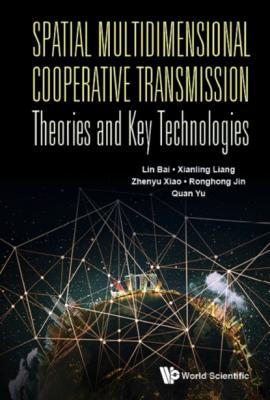Spatial Multidimensional Cooperative Transmission Theories And Key Technologies. Lin Bai
Читать онлайн.| Название | Spatial Multidimensional Cooperative Transmission Theories And Key Technologies |
|---|---|
| Автор произведения | Lin Bai |
| Жанр | Зарубежная компьютерная литература |
| Серия | |
| Издательство | Зарубежная компьютерная литература |
| Год выпуска | 0 |
| isbn | 9789811202476 |
The symbol received in the second symbol period is
where each symbol is divided by
It can be seen that the two symbols are extended on two antennas over two symbol periods. Therefore, Heff represents a space–time channel. Adding the matched filter
where n′ satisfies
It shows that the Alamouti algorithm cannot provide array gain due to a lack of information about the transmitting channel (note E{||h||2} = MT = 2).
However, for independent and identically distributed Rayleigh channels, the average bit error rate of the above problem has the following upper bound at high SNR.
It means that despite the lack of transmit channel information, the diversity gain is equal to MT = 2, which is the same as the transmit maximum ratio combining. From a global perspective, the Alamouti algorithm has a lower performance than the transmit or receive maximum ratio combining due to its zero array gain.
2.3.3.3Indirect transmit diversity
The technique of obtaining space diversity by combining or space–time coding described above belongs to the direct transmit diversity technique. By using well-known SISO techniques, converting space diversity to time or frequency diversity can also be realized.
Assuming MT = 2, the phase shift is achieved by delaying the signal on the second transmit branch by one symbol period or by selecting the appropriate frequency shift. If the channels h1 and h2 are independent and identically distributed Rayleigh channels, the space diversity (using two antennas) is converted to frequency and time diversity, respectively. Indeed, the receiver has a frequency or time fading problem for an effective two-branch summed SISO channel, which can be overcome by conventional diversity techniques, such as forward error correction or interleaving for frequency diversity.
2.3.4MIMO system
As mentioned above, in order to obtain a sufficiently high transmission rate, we can install multiple antennas on both the transmitter and the receiver to improve the spectral efficiency. The corresponding multi-antenna system is also called the MIMO system. When multiple antennas are used at both ends of the link, in addition to improving diversity gain and array gain, the system’s throughput can also be increased by the spatial multiplexing capability of the MIMO channel. However, it must be pointed out that it is impossible to maximize spatial multiplexing capability and diversity gain simultaneously. Besides, the array gain in the Rayleigh channel is also limited, which is smaller than MRMT. In the following, the MIMO technologies will be classified according to the understanding of the channel information by the transmitter.
2.3.4.1MIMO system with complete transmit channel information
(1) The dominant eigenmode transmission
First, the diversity gain of the MR × MT MIMO system is maximized, which can be realized by selecting MT × 1 weight vector WT and transmitting the same signal from all transmit antennas. In the receiving array, the antenna outputs are combined into a scalar signal z according to the MR × 1 weight vector WR. Thereafter, the transmission can be expressed as
By maximizing
where UH and VH are MR × r(H) and MT × r(H) dimensional unitary matrices, respectively. r(H) is the rank of matrix H and ΣH = diag{σ1, σ2, . . . , σr(H)} is a singular value diagonal matrix containing matrix H. By the decomposition of the channel matrix, it can be clearly seen that when WT and WR are the transmitting and receiving singular vectors corresponding to the maximum singular value σmax = max{σ1, σ2, . . . , σr(H)} of H, the received SNR is maximized.6 This technique is known as the dominant eigenmode transmission, and Eq. (2.125) can be rewritten as
where the variance of
As can be seen from Eq. (2.127), the array gain is equal to
The
